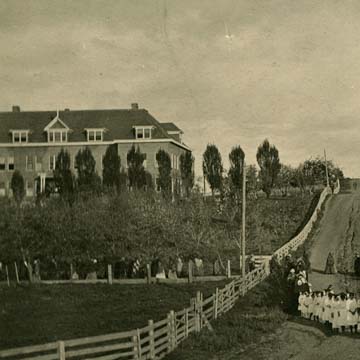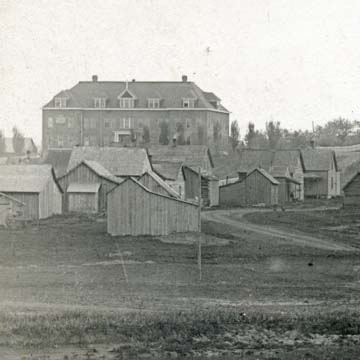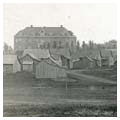You are here
Mary Immaculate School
The 1909 Mary Immaculate School was the dominant building within the Mission of the Sacred Heart at DeSmet, on the Coeur d’Alene Reservation in north central Idaho. The boarding school, commonly known as the Sisters’ Building, was established in 1878 in response to Coeur d’Alene Chief Andrew Seltice’s multiple requests (initiated in 1870) for “women blackrobes” (Catholic nuns) to educate girls. The school was a prominent landmark along Idaho’s primary north-south highway until the building burned in 2011.
DeSmet was the third location of the Mission of the Sacred Heart that Jesuits established for the Coeur d’Alene people. The first location was along the southern end of Lake Coeur d’Alene, established by Father Nicholas Point and Brother Charles Huet in 1842, but abandoned in 1846 after repeated flooding. The second mission site was on a hill overlooking the Coeur d’Alene River 27 miles east of the lake, and it was for this site, now known as Cataldo, that Father Antonio Ravalli designed a magnificent new church with a Baroque pediment and Greek Revival portico, built by Coeur d’Alene people using local materials.
The Sacred Heart Mission at Cataldo was not just a church; it was planned to be an agrarian mission village similar to previous Jesuit “reductions” in Paraguay. The mission became a productive, self-sustaining community where people raised livestock and grew food. Nonetheless, the location was problematic and there were strategic reasons for the move to a traditional camas field near Hangman Creek, about 70 miles to the south.
For the Jesuits, the Cataldo site was too isolated and inaccessible to market food the mission produced. In addition, the land near the mission was inadequate to support the number of Coeur d’Alene people living there. Finally, the mission was likely to be overrun by European Americans. The Jesuits looked favorably on the move to the new area, now known as the Palouse, as it had the capacity to consolidate the Coeur d’Alene population in one place and follow the reduction model more closely. Among Father Alexander Diomedi’s arguments why the Coeur d’Alenes should move was to have land for sisters to come and teach the children.
Between 1870 and 1875, Chief Seltice had already moved his established agricultural operations here, to a region characterized by rolling hills and fertile soil with abundant timber, farmland, and water. Chief Seltice and mission fathers encouraged all tribal members to relocate to claim the rich farmland before white settlers moved in. Chief Seltice further encouraged people to cultivate as much tribal land as possible to solidify their claim to the land.
In 1877, Father Diomedi moved the Mission of the Sacred Heart to the new location, named DeSmet after the Jesuit Pierre-Jean De Smet. With both the chief and the Jesuits encouraging people to move to DeSmet, most did. By 1879, 54 farms were operating in the area, most with a small log house or barn, and DeSmet was laid out as a small village of streets and alleys.
Upon arriving at DeSmet, the Jesuits opened a school for boys. With the assistance of the priests, Chief Seltice petitioned the Sisters of Charity of Providence to establish a convent and girls’ boarding school. Three sisters moved into their convent on December 1, 1878 and began teaching 30 girls and boys the next day.
The initial convent and school, built in anticipation of the Sisters’ arrival, was a humble log building, 60 by 30 feet. In December 1881, fire destroyed part of this original structure along with a dormitory wing and small storage building. In July 1882 construction began on a new convent and school; this frame building, erected with timber cut and milled on the reservation, remained in use until it burned in 1908.
The same day as the fire—February 10, 1908—the Reservation Agent was in Washington, D. C., to negotiate building a public school for Coeur d’Alene children. Members of the Coeur d’Alene Tribe were also there, to argue vehemently against the public school and to state their wish for the sisters to continue to educate their children. In response, the agents dropped the public school project and gifted the mission 800 tillable acres and 460 acres of timber land “for the duration and support of the school.” After the General Council gave permission to rebuild, construction on a new convent and school began in June 1908 and was completed a year later.
Prominently sited on a hill, the primary building was a symmetrical, three-story, I-shaped brick structure over a rubble basalt raised basement. Connected to its back was a smaller two-story, rectangular building, also of brick and with a hip roof. The primary building had a truncated hip roof punctuated by dormers on all sides, most of which had hip roofs over a pair of double-hung windows. Tall double-hung windows, single and paired, illuminated the first and second floors and shorter double-hung windows illuminated the basement. The central main entrance was emphasized at all three floors. A raised portico at the first floor, with pairs of columns supporting an entablature, framed a row of three doors, all glazed and with transoms. Directly above at the second floor was a row of three double-hung windows. At the third floor, three double-hung windows were framed by slender colonnettes and crowned by a large gabled dormer surmounted by a cross.
Girls at Mary Immaculate School learned skills such as sewing, cleaning, laundering, and gardening in addition to academic subjects and sometimes French or music. The mission included an orchard, vegetable gardens, and a large dairy, and students participated in food production with their teachers. They also participated in various church activities, sports, and even tribal dancing. In general, however, the school aimed to distance children from traditional culture, cutting their long hair, dressing them in western clothes, and forbidding them to speak their own language. This education was intended to prepare children to succeed in the modern United States, but it came at a cost, distancing them from their tribal elders and leading them to lose their traditional language and culture.
The school closed in 1974 and the Sisters of Charity of Providence gave title of the building to the Coeur d’Alene Tribe. Though the Tribe used the school for the Education Department and a cutting and sewing industry, it was also interested in preserving the building as an interpretive center. In 1975 the former school was nominated to the National Historic Register. In 2011, when the building was used only for storage and telecommunications, it burned to the ground. The loss of the most prominent building along a 90-mile stretch of US-95 was a shock, especially for Coeur d’Alene people. Coeur d’Alene Tribal Chairman Chief Allan characterized the building’s demise as “a big loss,” continuing, “Part of our history is gone. The memories will always be with our people, but it is a sad day for the Tribe.”
Nonetheless, the building remains vivid to elders who attended the school, in memories both good and bad. The haircutting, loss of language, and other assimilation practices were difficult for many people, but the school also helped students master the English language and gave them other skills to meet challenges of contemporary life. To preserve all these memories, in 2017 the Tribe created a series of interpretive and memorial panels with photographs of the school and its students.
When it stood, the Mary Immaculate School was a potent symbol of Coeur d’Alene Chief Andrew Seltice’s wisdom in urging the move to DeSmet and emphasizing education for all Coeur d’Alene children. It also embodied the relationship between Coeur d’Alene people and the Catholic Church. Reflecting on this relationship, Ernie Stensgar, vice chair of the Coeur d’Alene Tribal Council and coordinator of the Sisters’ Building memorial project, noted that the school existed because of the foresight of tribal leaders who understood that “we couldn’t get any place unless we were educated.” As a result, he continued, “This is a sacred site. What makes it sacred? Not the nuns, not the church, not the people over there. It's sacred because our people were here. This is where they shed blood and this is where they had their dreams, their vision of what we were going to be. This is us, and that’s why this site is sacred.”
References
Bischoff, William N. The Jesuits in Old Oregon, 1840–1940. Caldwell, ID: Caxton Printers, 1945.
Carriker, Robert C. “Direct Successor to DeSmet: Joseph M. Cataldo, S.J., and the Stabilization of the Jesuit Indian Missions of the Pacific Northwest, 1877-1893.” Idaho Yesterdays31, no. 1-2 (Spring–Summer 1987): 8-12.
Dozier, Jack. “History of the Coeur d’Alene Indians to 1900.” University of Idaho, 1961.
Heilman, Devin, “Tribe Honors Sacred Site.” Coeur d’Alene Press, October 27, 2017.
Mason, Helen. History of Providence Mary Immaculate, DeSmet, Idaho, Foundation #59.Sisters of Providence, 1996.
Prager, Mike, "Historic school building burns in DeSmet.” Spokesman-Review,February 3, 2011.
Wells, Merle W., “Coeur d’Alene Mission of the Sacred Heart, Desmet,” Benewah County, Idaho. National Register of Historic Places Inventory-Nomination Form, 1975. National Park Service, U. S. Department of the Interior, Washington, D.C.
Woodworth-Ney, Laura. Mapping Identity: The Creation of the Coeur d’Alene Indian Reservation, 1805–1902. Boulder: University of Colorado Press, 2004.
Writing Credits
If SAH Archipedia has been useful to you, please consider supporting it.
SAH Archipedia tells the story of the United States through its buildings, landscapes, and cities. This freely available resource empowers the public with authoritative knowledge that deepens their understanding and appreciation of the built environment. But the Society of Architectural Historians, which created SAH Archipedia with University of Virginia Press, needs your support to maintain the high-caliber research, writing, photography, cartography, editing, design, and programming that make SAH Archipedia a trusted online resource available to all who value the history of place, heritage tourism, and learning.






